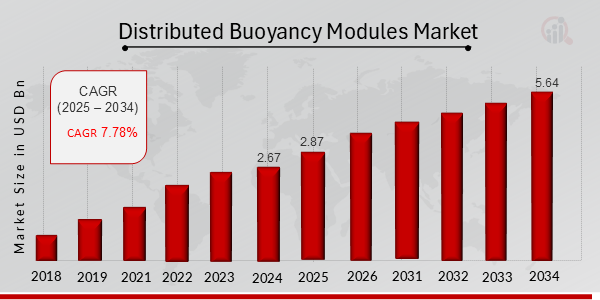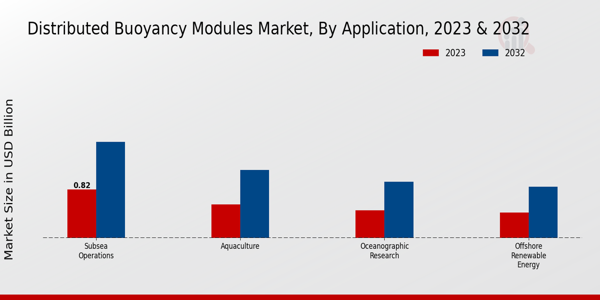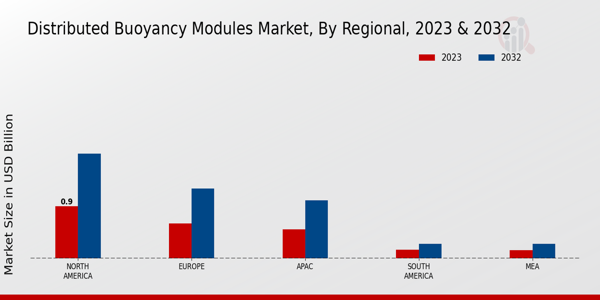Distributed Buoyancy Modules Market Overview
As per MRFR analysis, the Distributed Buoyancy Modules Market Size was estimated at 2.67 (USD Billion) in 2024. The Distributed Buoyancy Modules Market Industry is expected to grow from 2.87 (USD Billion) in 2025 to 5.64 (USD Billion) till 2034, at a CAGR (growth rate) is expected to be around 7.78% during the forecast period (2025 - 2034).
Key Distributed Buoyancy Modules Market Trends Highlighted
The Distributed Buoyancy Modules Market is witnessing a significant growth driven by increasing demand for underwater exploration and infrastructure development. This shift stems from the rising activities in sectors such as oil and gas, renewable energy, and environmental monitoring. The need for advanced technology in subsea applications brings about higher efficiency and safety, leading to greater adoption of distributed buoyancy modules. Additionally, the push toward sustainable energy sources is propelling investments in offshore wind and tidal energy projects, which further fuels the market growth.
Opportunities abound in the emergence of smart buoyancy technology, which presents the potential for enhanced operational performance and data collection capabilities. New materials and manufacturing practices are also allowing for the construction of smaller, stronger modules that can be immersed in deep-sea conditions. Cost optimization and long-lasting projects will lead to a demand for configurable solutions to individual operational modes. Furthermore, the interaction of technology providers and end-users may combine efforts, resulting in breakthroughs. Recently, there has been a gradual increase in attention towards ecological endeavors and/however, the minimization of carbon footprints alters the forces that drive the market.
Therefore, manufacturers are beginning to investigate biodegradable and recyclable materials for buoyancy elements in regard to the ecological target.
The increasing necessity for remote monitoring and automation is also influencing product development, propelling the integration of smart sensors into buoyancy modules. As industries adopt digitalization and automation strategies, the demand for connected devices is expected to rise, further transforming the landscape of the distributed buoyancy modules market.

Source: Primary Research, Secondary Research, MRFR Database and Analyst Review
Distributed Buoyancy Modules Market Drivers
Increasing Demand for Offshore Exploration
The Distributed Buoyancy Modules Market Industry is witnessing a significant surge in demand due to the increasing interest in offshore exploration activities. As conventional onshore oil and gas resources become scarcer, companies are expanding their focus to offshore reserves, which are often located in deeper waters. This shift necessitates advanced technologies and equipment that can support robust operations in challenging marine environments, making distributed buoyancy modules a crucial component in providing stability and support to offshore installations.
The growing investments in subsea infrastructure and the need for efficient buoyancy solutions to ensure the safe and effective deployment of drills and other subsea equipment are driving the market forward. These modules offer unique benefits that enhance operational efficiency and reduce risk, enabling energy companies to optimize their subsea development strategies. The push for cleaner and more sustainable energy sources is also a factor in the rise of offshore renewables, which further promotes the use of distributed buoyancy modules, as they are essential for floating wind turbines and other offshore renewable energy projects.
Given these conditions, the projected growth in offshore activities is expected to propel the Distributed Buoyancy Modules Market to new heights as companies seek to enhance their operational capabilities and streamline their investment in advanced buoyancy solutions.
Technological Advancements in Marine Equipment
Technological innovation is a key driver in the Distributed Buoyancy Modules Market Industry, propelling its growth in recent years. Continuous advancements in materials science and engineering have led to the development of more effective buoyancy materials that enhance the performance and durability of these modules. Innovations such as lightweight composites and smart materials not only improve buoyancy efficiency but also offer greater resistance to harsh marine conditions.Additionally, the adoption of automation and digital technologies in marine operations is increasing the demand for advanced buoyancy solutions. This evolution of technology within the marine sector ensures that buoyancy modules are better equipped to meet the operational requirements of a dynamic industry while also ensuring safety and reliability.
Rising Investment in Marine Renewable Energy Projects
The growing focus on renewable energy sources is driving significant investment in marine energy projects, which utilize distributed buoyancy modules. Governments and private companies are increasingly recognizing the potential of offshore wind, wave, and tidal energy as key areas for future energy production. These projects require efficient buoyancy solutions to support the installation of turbines and other infrastructure, thereby creating a sizeable market for distributed buoyancy modules.The Distributed Buoyancy Modules Market Industry is poised to benefit from this shift towards sustainable energy solutions as funding and resources are allocated towards the development of marine energy infrastructures.
Distributed Buoyancy Modules Market Segment Insights
Distributed Buoyancy Modules Market Application Insights
The Distributed Buoyancy Modules Market, particularly in the Application segment, is experiencing notable growth and significant market valuations. By 2023, the market valuation stands at 2.29 USD Billion, reflecting the increasing demand for these modules across various operational sectors. The segmentation of the market reveals that Subsea Operations holds a major share, currently valued at 0.82 USD Billion in 2023 and expected to grow to 1.63 USD Billion by 2032. This sub-segment plays a crucial role in underwater explorations and installations, where buoyancy control is essential for the stability and safety of operations. Aquaculture follows closely, with a current valuation of 0.57 USD Billion projected to reach 1.15 USD Billion by 2032. The rising demand for seafood and sustainable fish farming practices drives the significance of buoyancy modules in maintaining optimal conditions for aquatic life. Oceanographic Research is also a noteworthy aspect of the market, valued at 0.47 USD Billion in 2023, extending to 0.95 USD Billion by 2032. This sector is critical for environmental monitoring and scientific research, with buoyancy modules facilitating the deployment of research equipment in challenging underwater conditions. Finally, Offshore Renewable Energy, currently valued at 0.43 USD Billion, is expected to increase to 0.87 USD Billion by 2032. This segment is becoming increasingly important as the demand for sustainable energy sources rises, with buoyancy modules supporting the deployment and maintenance of offshore wind farms and other renewable infrastructure. The combined growth in these sectors contributes to an overall positive trend within the Distributed Buoyancy Modules Market. Key drivers for growth include advances in marine technology and increasing investments in both research and renewable energy. However, challenges such as environmental regulations and high initial investment costs may influence market dynamics. Despite these challenges, numerous opportunities exist due to the rising focus on sustainability and environmental protection, emphasizing the importance of buoyancy modules in facilitating diverse applications across these segments and enhancing efficiency in operations. This data and the projected continued growth underline the crucial role that the Application segment plays in the overall expansion of the Distributed Buoyancy Modules Market revenue.

Source: Primary Research, Secondary Research, MRFR Database and Analyst Review
Distributed Buoyancy Modules Market Product Type Insights
The Distributed Buoyancy Modules Market has gained significant traction, showcasing a valuation of 2.29 USD Billion in 2023 and projected growth as the market evolves. Within this market, the product type segmentation highlights a variety of offerings that cater to diverse industry needs. Modular Buoyancy Systems have emerged as a major player, offering flexible and scalable solutions that allow for ease of transport and installation, thus garnering attention from various sectors. Inflatable Buoyancy Modules are also recognized for their lightweight nature and ease of deployment, making them ideal for marine applications and temporary operations.Additionally, Composite Buoyancy Products are becoming increasingly relevant due to their durability and resistance to harsh environments, appealing to sectors such as offshore oil and gas. As these product types align with current market trends, including the rise of sustainable offshore technologies, the Distributed Buoyancy Modules Market data suggests that the industry's revenue will continue to grow, navigating challenges while seizing opportunities driven by innovation and robust demand.
Distributed Buoyancy Modules Market Material Type Insights
The Distributed Buoyancy Modules Market is poised for notable growth in the coming years, with a market value reaching 2.29 billion USD by 2023. The material type segment plays a pivotal role in this market, encompassing materials such as Polyethylene, Polyurethane, Fiberglass, and Metal. Each material type offers unique advantages that cater to specific industry requirements. For instance, Polyethylene is recognized for its lightweight and corrosion-resistant properties, making it highly suitable for various applications. Polyurethane, with its ability to be formulated for different rigidity levels, serves as an ideal option for varied buoyancy needs.Fiberglass, known for its durability and strength, is often favored in demanding environments. Conversely, Metal materials provide robustness and are commonly used in high-load applications. Collectively, these materials drive the Distributed Buoyancy Modules Market industry forward, supported by increasing demand across sectors such as marine, oil and gas, and renewable energy. As the market evolves, the diverse capabilities of these material types are expected to shape the future landscape, directly influencing the Distributed Buoyancy Modules Market data and revenue.
Distributed Buoyancy Modules Market End Use Insights
The Distributed Buoyancy Modules Market is poised for significant growth within the End Use segment, showcasing a market value of 2.29 billion USD in 2023. Within this framework, the Marine Industry plays a pivotal role, utilizing distributed buoyancy modules for enhanced operational efficiency and safety on the water. The Oil and Gas sector maintains a dominant position due to its ongoing exploration activities, where buoyancy solutions are critical for offshore drilling and pipeline installations. Research Institutions utilize these modules for various experimental applications, contributing significantly to the technological advancements in buoyancy systems.Environmental Agencies also adopt these solutions for monitoring and environmental protection efforts, addressing pollution and marine ecosystem management. This diverse array of end-use applications facilitates a robust segmentation, allowing the overall market to adapt to different industry demands while fostering sustainable practices in marine exploration and conservation efforts. As trends shift towards eco-friendly solutions, the importance of buoyancy modules in addressing environmental challenges and enhancing operational capabilities continues to gain traction across these industries.
Distributed Buoyancy Modules Market Regional Insights
The Distributed Buoyancy Modules Market is characterized by diverse regional segments, each playing a crucial role in its overall dynamics. In 2023, North America emerged as a significant contributor, valued at 0.9 USD Billion, and is projected to reach 1.8 USD Billion by 2032, highlighting its majority holding in the market due to strong industrial applications and technological advancements. Europe follows with a valuation of 0.6 USD Billion in 2023, set to grow to 1.2 USD Billion by 2032, bolstered by increasing investments in offshore projects.The APAC region, valued at 0.5 USD Billion in 2023, is anticipated to grow to 1.0 USD Billion by 2032, reflecting a rising demand for buoyancy solutions in emerging markets. South America and MEA, while smaller in comparison at 0.15 USD Billion and 0.14 USD Billion, respectively, in 2023, show potential growth, reaching 0.25 USD Billion by 2032, driven by exploration activities and infrastructure development. Overall, the Distributed Buoyancy Modules Market data suggests a robust growth trajectory across these regions, influenced by technology trends and regional demands.

Source: Primary Research, Secondary Research, MRFR Database and Analyst Review
Distributed Buoyancy Modules Market Key Players and Competitive Insights
The Distributed Buoyancy Modules Market has witnessed significant development in recent years, driven by advancing technologies and increasing demand for innovative solutions in various industries such as oil and gas, marine exploration, and underwater construction. Competitive insights in this market reveal a diverse landscape where established players compete alongside emerging companies, striving for innovation and customer satisfaction. Factors such as product differentiation, strategic partnerships, and sustainability practices play crucial roles in shaping competitive strategies. Companies aim to enhance their market share by improving the resilience and functionality of buoyancy modules, catering to varying customer specifications, and promoting eco-friendly materials. The competitive dynamics are characterized by ongoing research and development efforts and aggressive marketing strategies designed to improve visibility and expand customer reach within this specialized sector.Faroe Petroleum is recognized within the Distributed Buoyancy Modules Market as a forward-thinking entity significantly contributing to product advancements and applications of buoyancy modules. The company leverages its expertise in offshore oil and gas exploration, where buoyancy modules play a critical role in enhancing efficiency and safety during deep-water operations. Faroe Petroleum has established a strong market presence due to its commitment to quality, performance-focused solutions, and customer-centric approach. By strategically investing in research and partnering with technology innovators, Faroe Petroleum is positioned to influence market trends and drive standards within the distributed buoyancy sector. Its ability to adapt to changing regulations and commitments to sustainability further strengthens its competitive stance, ensuring resilient growth in the evolving landscape.SGS SA operates prominently in the Distributed Buoyancy Modules Market, with a distinct focus on providing comprehensive inspection, verification, testing, and certification services. The company's expertise in quality assurance and regulatory compliance allows it to serve a critical role within the buoyancy modules supply chain. Through its extensive presence across multiple regions, SGS SA is well-equipped to assist clients in achieving performance standards and ensuring product integrity, which is vital in marine and offshore applications. Its commitment to innovation and technological advancements, coupled with a strong emphasis on customer relationships, enhances its ability to deliver customized solutions that meet the unique challenges of the market. By maintaining stringent quality controls and offering insight into compliance measures, SGS SA contributes to elevating industry benchmarks and fostering confidence among clients and stakeholders in the distributed buoyancy modules sector.
Key Companies in the Distributed Buoyancy Modules Market Include
- Faroe Petroleum
- SGS SA
- Bourbon Corporation
- Oceaneering International
- Prysmian Group
- Innosea
- Schlumberger
- Neptune Energy
- Deep Ocean
- Saipem
- TechnipFMC
- Marine Systems
- Aker Solutions
- Subsea 7
- Fugro NV
Distributed Buoyancy Modules Market Industry Developments
Recent developments in the Distributed Buoyancy Modules Market highlight a growing focus on innovation and sustainability. Companies such as TechnipFMC and Aker Solutions are expanding their product offerings to enhance operational efficiency and reduce environmental impact. Meanwhile, Faroe Petroleum and Neptune Energy are actively engaging in projects aimed at advancing subsea technologies that leverage distributed buoyancy modules for improved performance in offshore operations. In terms of market dynamics, a notable trend is the increasing investment in renewable energy projects, which is driving demand for advanced buoyancy solutions from firms like Oceaneering International and Subsea 7. Additionally, merger and acquisition activities continue to shape the landscape; for instance, Deep Ocean and Fugro NV are exploring strategic partnerships to strengthen their service capabilities in the buoyancy module sector. The financial health of companies like Bourdon Corporation and Prysmian Group remains solid, reflecting a competitive environment spurred by technological advancements and an emphasis on cost-effective solutions. This evolving dynamic points toward significant growth potential within the market, influencing investment strategies and operational priorities of key players.
Distributed Buoyancy Modules Market Segmentation Insights
- Distributed Buoyancy Modules Market Application Outlook
- Subsea Operations
- Aquaculture
- Oceanographic Research
- Offshore Renewable Energy
- Distributed Buoyancy Modules Market Product Type Outlook
- Modular Buoyancy Systems
- Inflatable Buoyancy Modules
- Composite Buoyancy Products
- Distributed Buoyancy Modules Market Material Type Outlook
- Polyethylene
- Polyurethane
- Fiberglass
- Metal
- Distributed Buoyancy Modules Market End Use Outlook
- Marine Industry
- Oil and Gas
- Research Institutions
- Environmental Agencies
- Distributed Buoyancy Modules Market Regional Outlook
- North America
- Europe
- South America
- Asia Pacific
- Middle East and Africa
| Report Attribute/Metric |
Details |
|
Market Size 2024
|
2.67 (USD Billion)
|
|
Market Size 2025
|
2.87 (USD Billion)
|
|
Market Size 2034
|
5.64 (USD Billion)
|
|
Compound Annual Growth Rate (CAGR)
|
7.78% (2025 - 2034)
|
|
Report Coverage
|
Revenue Forecast, Competitive Landscape, Growth Factors, and Trends
|
|
Base Year
|
2024
|
|
Market Forecast Period
|
2025 - 2034
|
|
Historical Data
|
2019 - 2023
|
| Market Forecast Units |
USD Billion |
| Key Companies Profiled |
Faroe Petroleum, SGS SA, Bourbon Corporation, Oceaneering International, Prysmian Group, Innosea, Schlumberger, Neptune Energy, Deep Ocean, Saipem, TechnipFMC, Marine Systems, Aker Solutions, Subsea 7, Fugro NV |
| Segments Covered |
Application, Product Type, Material Type, End Use, Regional |
| Key Market Opportunities |
Increased offshore exploration activities, Growing demand for underwater robotics, Advancements in buoyancy materials, Expanding renewable energy sector, Rising naval defense initiatives |
| Key Market Dynamics |
Technological advancements in materials, Rising offshore exploration activities, Increasing demand for seismic studies, Growing renewable energy sectors, Enhanced safety regulations and standards |
| Countries Covered |
North America, Europe, APAC, South America, MEA |
Frequently Asked Questions (FAQ) :
The Distributed Buoyancy Modules Market is expected to be valued at 5.64 USD Billion in 2034.
The market is expected to witness a CAGR of 7.78% from 2025 to 2034.
The Subsea Operations segment is projected to reach 1.63 USD Billion by 2032.
North America is expected to have a market value of 1.8 USD Billion in 2032.
The Aquaculture application is anticipated to reach a market size of 1.15 USD Billion by 2032.
Major players include Schlumberger and Oceaneering International.
The Offshore Renewable Energy application is expected to be valued at 0.87 USD Billion by 2032.
The APAC region is anticipated to reach a market value of 1.0 USD Billion by 2032.
Oceanographic Research is expected to have a market value of 0.95 USD Billion by 2032.
Both South America and the Middle East Africa (MEA) are projected to reach 0.25 USD Billion by 2032.

















